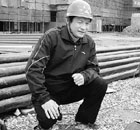Asia-Pacific
BP's next try to stem oil gusher: Smaller tube
(Agencies)
Updated: 2010-05-14 06:28
 |
Large Medium Small |
WASHINGTON – BP officials said Thursday they would thread a small tube into a jagged pipe on the seafloor to suck oil to the surface before it can spew into the Gulf and add to a disaster apparently set in motion by a long list of equipment failures.
 A Coast Guard plane flies over the Development Driller III oil drilling platform which is drilling a relief well at the site of the Deepwater Horizon oil spill in the Gulf of Mexico off the coast of Louisiana Wednesday, May 12, 2010. [Agencies] |
Engineers will have to make sure the 6-inch-wide tube is inserted deep enough into the 21-inch-wide pipe so gas and seawater don't mix, which can form crystals that could clog the tube. They'll also have to thread the tube into the pipe without hitting debris around the riser.
Company spokesman Bill Salvin said engineers hope to start moving the tube into place Thursday night, but it will take 12 hours to get the tube fully hooked up. Another option is a small containment box called a "top hat," which is already on the seafloor and also would siphon oil to a tanker on the surface.
Officials are waiting to use the box until they know if the tube works, and how well it's working, Salvin said. Engineers still might consider trying to fill the leak with golf balls and other debris — the "junk shot," though that won't be until at least next week. And a relief well is being drilled, but that is at least two months away.
BP's updates came a day after hearings in Washington and Louisiana uncovered a checklist of unseen breakdowns on largely unregulated aspects of well safety that apparently contributed to the April 20 blowout aboard the Deepwater Horizon: a leaky cement job, a loose hydraulic fitting, a dead battery. Company officials insist what caused the accident is not yet clear.
The trail of problems highlights the reality that, even as the US does more deepwater offshore drilling in a quest for domestic oil, some key safety components are left almost entirely to the discretion of the companies doing the work.
It remains unclear what, if anything, Congress or the Obama administration may do to address these regulatory deficiencies.
So far, Interior Secretary Ken Salazar has proposed splitting his department's Minerals Management Service in two to make safety enforcement independent of the agency's other main function — collecting billions in royalties from the drilling industry.
But the events that unfolded in the hours before the blowout on the Deepwater Horizon suggest much more will need to be done on the regulatory front.
As the day of the catastrophe got under way on the drilling platform 48 miles off Louisiana, workers were stabilizing the mile-deep exploratory well to mothball until production.
Shortly after midnight, nearly 22 hours before the explosion, contractor Halliburton finished pumping cement into the well. Heavy cement is used to fill gaps around the drill piping and block any surge of natural gas or oil.
As part of the planned routine, the workers next capped the drill pipe with the first of multiple cement plugs. The plugs are meant to stop any upsurge of gas or oil inside the piping.
The cement and metal casing along well walls were then checked. Positive pressure tests indicated they were sound. However, there are no federal standards for the makeup of the crucial cement filler.
The well's operator, BP PLC, said Thursday its costs for trying to stop the gusher, containing the spill and helping Gulf states foot the response tab totaled $450 million, up $100 million since its May 10 update to securities regulators. BP Chief Operating Officer Doug Suttles has said the bill increases by at least $10 million a day.
According to the testimony and other evidence that has emerged this week, the first sign of trouble came shortly before dawn. Workers pumped out heavy drilling fluid for a negative pressure test to make sure underground gas couldn't seep into the well. That test failed: it meant the well might be leaking. Another test was run. It too failed.
Workers debated what to do next. They eventually decided to resume work.
Further reducing protection from a blowout, heavy drilling fluid was pumped out of a pipe rising to the surface from the wellhead. It was replaced with lighter seawater in preparation for placing the last cement plug.
Federal rules say an operator must hold newly cemented well-wall casing under pressure for up to 12 hours before resuming drilling. Other than that, there are few rules about how long to let cement set.
Whatever the main cause — cement or something else — the last plug was still missing just before 10 p.m. on the 20th, when drilling fluid pushed by underground gas started kicking up uncontrollably through the well.
Desperate rig workers tried to activate a set of hydraulic cutoff valves known as a blowout preventer to squeeze off the surge. However, hydraulic fluid was leaking from a loose fitting in the preventer's emergency system, making it harder to activate powerful shear rams to cut the piping and cap the blowout. Also, a battery had gone dead in at least one of two control pods meant to automatically switch on the preventer in an emergency.
As gas pushed upward on the Deepwater Horizon, it suddenly ignited from an unknown source and turned the platform into an enormous fireball. Eleven people were killed.
The preventer "was to be the fail-safe in case of an accident," Lamar McKay, the president of BP America, said at the House hearing.
Yet industry officials acknowledged a fistful of regulatory and operational gaps: There is no government standard for design or installation of blowout preventers. The federal government doesn't routinely inspect them before they are installed. Their emergency systems usually go untested once they are set on the seafloor at the mouth of the well. The federal government doesn't require a backup.
In one telling exchange Wednesday at a hearing of the Coast Guard and MMS in Kenner, La., Coast Guard Capt. Hung Nguyen asked a regional supervisor of the federal regulatory agency a question about blowout preventers: "It's my understanding that it's designed to industry standard and it's manufactured by the industry, installed by the industry, with no government witnessing or oversight of the construction or installation. Is that correct?"
"That is correct," replied Michael Saucier, the MMS field supervisor for the Gulf.










